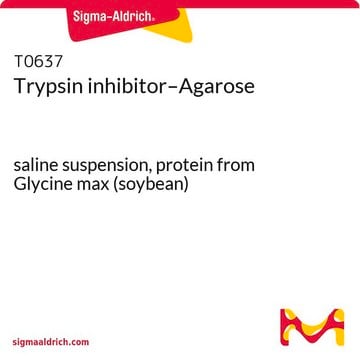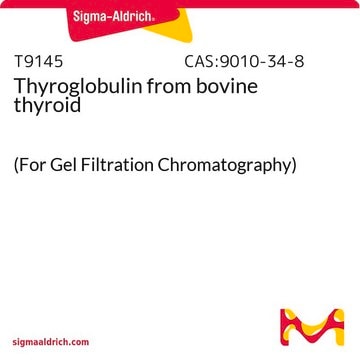10109886001
Roche
Trypsin Inhibitor
from soybean
Sinónimos:
trypsin
Iniciar sesiónpara Ver la Fijación de precios por contrato y de la organización
About This Item
Código UNSPSC:
12352207
Productos recomendados
origen biológico
soybean
Nivel de calidad
formulario
lyophilized
mol peso
Mr 20,100
envase
pkg of 50 mg
fabricante / nombre comercial
Roche
concentración
1 mg/mL
técnicas
cell culture | mammalian: suitable
pH
3.8-4.5
solubilidad
water: soluble
temp. de almacenamiento
2-8°C
Descripción general
Soybean trypsin inhibitor (STI) comprises 181 amino acids. It is a monomeric protein corresponding to a molecular weight of 20 kDa and has two disulfide bridges. It belongs to serpins − serine protease inhibitors family.
Especificidad
Soybean trypsin inhibitor is an inhibitor for trypsin, plasmin, and plasma kallikrein. It inhibits trypsin, factor Xa, plasmin, and plasma kallikrein activity in serum-free cell culture media. It does not inhibit metallo-, cysteine, aspartic proteases, or tissue kallikrein (serine proteases).
Aplicación
Trypsin Inhibitor from soybean is used to terminate tissue disaggregation and for subcultivation procedures.
Trypsin Inhibitor has been used:
- in the buffer for hepatocyte isolation
- to inhibit trypsin in Corneal epithelial cells
- to inhibit papain activity while treating hippocampal neural stem cells (NSCs)
Acciones bioquímicas o fisiológicas
Soybean trypsin inhibitor (STI) inhibits myc proto-oncogene protein and is anticarcinogenic. It favors anti-aggregation of platelets and may be a potential protease inhibiting drug. STI inhibits renin and angiotensin.
Soybean trypsin inhibitor is an inhibitor for trypsin, plasmin, and plasma kallikrein. The product is sensitive to heat, alkaline pH, and protein-precipitating compounds.
Especificaciones
Inhibiting activity: approximately 70 trypsin inhibitor units/mg lyophilizate at +25°C with benzoyl-L-arginine ethylester as a substrate (approximately 190 trypsin inhibitor units/mg at +25°C with Chromozym TRY as substrate)
Isoelectric point: 4.5
Isoelectric point: 4.5
Definición de unidad
1 U = 270 S & T-units or 90 USP-units
Nota de preparación
Working concentration: 10 to 100 μg/ml
Working solution: Recommended solvent is distilled water.
Stock solution: 1 mg/ml
Storage conditions (working solution): -15 to -25 °C
The enzyme is stable for 6 months, frozen in aliquots.
Working solution: Recommended solvent is distilled water.
Stock solution: 1 mg/ml
Storage conditions (working solution): -15 to -25 °C
The enzyme is stable for 6 months, frozen in aliquots.
Reconstitución
Sensitive to heat, alkaline pH, and protein-precipitating compounds.
Almacenamiento y estabilidad
Store at 2 to 8 °C. (Store dry!)
Otras notas
For life science research only. Not for use in diagnostic procedures.
Código de clase de almacenamiento
11 - Combustible Solids
Clase de riesgo para el agua (WGK)
WGK 2
Punto de inflamabilidad (°F)
Not applicable
Punto de inflamabilidad (°C)
Not applicable
Certificados de análisis (COA)
Busque Certificados de análisis (COA) introduciendo el número de lote del producto. Los números de lote se encuentran en la etiqueta del producto después de las palabras «Lot» o «Batch»
¿Ya tiene este producto?
Encuentre la documentación para los productos que ha comprado recientemente en la Biblioteca de documentos.
Los clientes también vieron
Mice, double deficient in lysosomal serine carboxypeptidases Scpep1 and Cathepsin A develop the hyperproliferative vesicular corneal dystrophy and hypertrophic skin thickenings
Pan X, et al.
PLoS ONE, 12(2), e0172854-e0172854 (2017)
Preparation of Primary Rat Hepatocyte Spheroids Utilizing the Liquid-Overlay Technique
Kyffin JA, et al.
Current Protocols in Toxicology / Editorial Board, Mahin D. Maines (editor-in-chief) ... [Et al.], 81(1), e87-e87 (2019)
Single cell transcriptomic analysis of renal allograft rejection reveals insights into intragraft TCR clonality.
Shi, et al.
The Journal of Clinical Investigation (2023)
Isolating Taste Buds and Taste Cells from Vallate Papillae of C57BL/6J Mice for Detecting Transmitter Secretion
Anthony Y. Huang and Sandy Y. Wu
CorpBase ID (for auto-filling citation data), 6(11) (2016)
Benjamin C Orsburn et al.
Nature communications, 13(1), 7246-7246 (2022-11-27)
Single cell proteomics is a powerful tool with potential for markedly enhancing understanding of cellular processes. Here we report the development and application of multiplexed single cell proteomics using trapped ion mobility time-of-flight mass spectrometry. When employing a carrier channel
Nuestro equipo de científicos tiene experiencia en todas las áreas de investigación: Ciencias de la vida, Ciencia de los materiales, Síntesis química, Cromatografía, Analítica y muchas otras.
Póngase en contacto con el Servicio técnico







